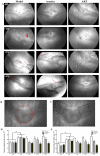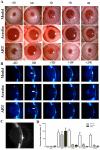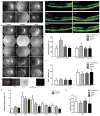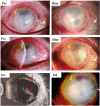Small Molecular-Sized Artesunate Attenuates Ocular Neovascularization via VEGFR2, PKCα, and PDGFR Targets
- PMID: 27480521
- PMCID: PMC4969591
- DOI: 10.1038/srep30843
Small Molecular-Sized Artesunate Attenuates Ocular Neovascularization via VEGFR2, PKCα, and PDGFR Targets
Abstract
Ocular neovascularization (NV) is the primary cause of blindness in many ocular diseases. Large molecular weight anti- vascular endothelial growth factor (VEGF) protein drugs, such as Avastin and Lucentis, have saved the vision of millions. However, approximately 20-30% of patients respond poorly to anti-VEGF treatment. We found that artesunate (ART), a small molecular derivative of artemisinin, had a significant inhibitory effect on ocular NV by downregulating the expression of VEGFR2, PKCα, and PDGFR. ART significantly inhibited retinal NV in rabbits and macular edema in monkeys with greater anterior chamber penetrability and more durable efficacy than Avastin. Our pilot study showed that intravitreal injection of 80 μg ART significantly inhibited iris and corneal NV in a severe retinal detachment case. Our results suggest that ART might be a potential persistent small-molecule drug to manage ocular NV via multi-targets.
Figures








Similar articles
-
Apatinib, an Inhibitor of Vascular Endothelial Growth Factor Receptor 2, Suppresses Pathologic Ocular Neovascularization in Mice.Invest Ophthalmol Vis Sci. 2017 Jul 1;58(9):3592-3599. doi: 10.1167/iovs.17-21416. Invest Ophthalmol Vis Sci. 2017. PMID: 28715845
-
Intravitreal sustained release of VEGF causes retinal neovascularization in rabbits and breakdown of the blood-retinal barrier in rabbits and primates.Exp Eye Res. 1997 Apr;64(4):505-17. doi: 10.1006/exer.1996.0239. Exp Eye Res. 1997. PMID: 9227268
-
A Pilot Clinical Study of Intravitreal Injection of Artesunate for Ocular Neovascularization.J Ocul Pharmacol Ther. 2019 Jun;35(5):283-290. doi: 10.1089/jop.2018.0097. Epub 2019 May 15. J Ocul Pharmacol Ther. 2019. PMID: 31090473
-
Molecular pathogenesis of retinal and choroidal vascular diseases.Prog Retin Eye Res. 2015 Nov;49:67-81. doi: 10.1016/j.preteyeres.2015.06.002. Epub 2015 Jun 23. Prog Retin Eye Res. 2015. PMID: 26113211 Free PMC article. Review.
-
Ocular neovascularization: Implication of endogenous angiogenic inhibitors and potential therapy.Prog Retin Eye Res. 2007 Jan;26(1):1-37. doi: 10.1016/j.preteyeres.2006.09.002. Epub 2006 Oct 30. Prog Retin Eye Res. 2007. PMID: 17074526 Review.
Cited by
-
Characterization and validation of a chronic retinal neovascularization rabbit model by evaluating the efficacy of anti-angiogenic and anti-inflammatory drugs.Int J Ophthalmol. 2022 Jan 18;15(1):15-22. doi: 10.18240/ijo.2022.01.03. eCollection 2022. Int J Ophthalmol. 2022. PMID: 35047351 Free PMC article.
-
Retinal safety and toxicity study of artesunate in vitro and in vivo.Adv Ophthalmol Pract Res. 2022 Dec 10;3(2):47-54. doi: 10.1016/j.aopr.2022.11.003. eCollection 2023 May-Jun. Adv Ophthalmol Pract Res. 2022. PMID: 37846375 Free PMC article.
-
Therapeutic potential of artesunate in retinal diseases: from mechanism to clinical applications.Int J Ophthalmol. 2025 Jun 18;18(6):1146-1151. doi: 10.18240/ijo.2025.06.22. eCollection 2025. Int J Ophthalmol. 2025. PMID: 40534801 Free PMC article. Review.
-
Potential applications of artemisinins in ocular diseases.Int J Ophthalmol. 2019 Nov 18;12(11):1793-1800. doi: 10.18240/ijo.2019.11.20. eCollection 2019. Int J Ophthalmol. 2019. PMID: 31741871 Free PMC article. Review.
-
The Potential Roles of Artemisinin and Its Derivatives in the Treatment of Type 2 Diabetes Mellitus.Front Pharmacol. 2020 Nov 26;11:585487. doi: 10.3389/fphar.2020.585487. eCollection 2020. Front Pharmacol. 2020. PMID: 33381036 Free PMC article.
References
Publication types
MeSH terms
Substances
LinkOut - more resources
Full Text Sources
Other Literature Sources
Miscellaneous

